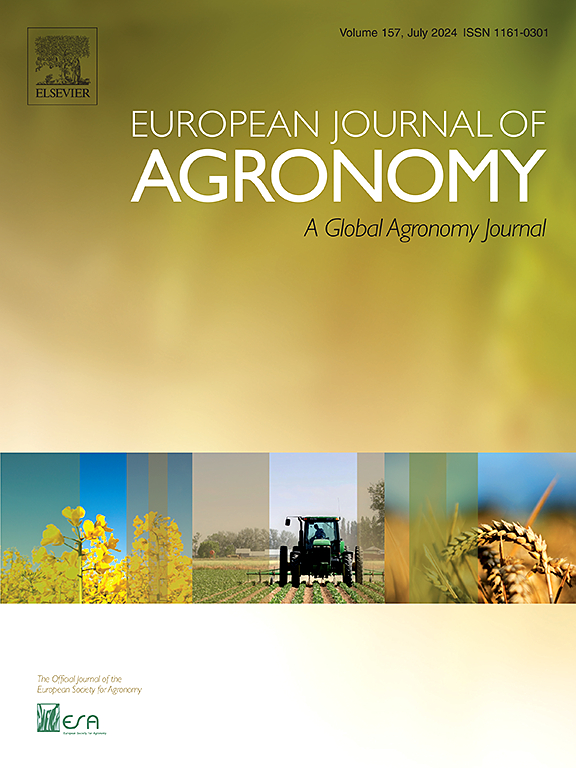Assessing genetics, biophysical, and management factors related to soybean seed protein variation in Brazil
IF 4.5
1区 农林科学
Q1 AGRONOMY
引用次数: 0
Abstract
The demand for high-quality soybeans is increasing. The composition of soybean grain can vary with genetics, biophysical, and management factors. In particular, studies on protein concentration are increasing worldwide. The objectives in this study were: (i) to quantify the genetic effects on seed protein concentration and (ii) to identify the biophysical and management factors affecting seed protein concentration in soybean production systems in Brazil. We collected soybean samples and crop management data through surveys in 194 soybean farms in two growing seasons (2018/2019; 2022/2023) across eleven states in Brazil. Seed protein was determined by the Kjeldahl method. Random forest regressions and comparisons between high and low protein fields to identify the main causes of variation in soybean protein concentration were used. Fields with highest protein concentration were observed in older cultivars released in (2011), at lower yields (3082 kg ha−1), late sowing (DOY 313), higher temperatures (25.6 °C−1) and a lower photothermal coefficient (0.79 MJ m−2 d−1 °C−1). Conversely, low protein concentration was observed in fields with higher yields (4220 kg ha−1), early sowing (DOY 313), lower temperatures (24.8°C−1) and a higher photothermal coefficient (0.84 MJ m−2 d−1 °C−1) and newer cultivars released in (2016). The regression tree and random forest explained 58 % of the protein variability, including cultivar (39 %), latitude (12 %) and sowing date (7 %). Cultivar was the most important factor affecting soybean protein concentration, followed by sowing date. The year of cultivar release, breeding company, latitude, temperature, photothermal coefficient and water supply also affected the final concentration of soybean seed protein. The results emphasize the need for breeding programs to evaluate protein concentration in new soybean varieties. Additionally, we now have clear biophysical and management indicators to help achieve higher protein concentrations in soybean crops.
评估巴西大豆种子蛋白质变异的遗传、生物物理和管理因素
对优质大豆的需求正在增加。大豆籽粒的组成因遗传、生物物理和管理因素而异。特别是在世界范围内,对蛋白质浓度的研究越来越多。本研究的目的是:(i)量化遗传对种子蛋白浓度的影响;(ii)确定巴西大豆生产系统中影响种子蛋白浓度的生物物理和管理因素。我们通过调查收集了194个大豆农场在两个生长季节(2018/2019;2022/2023)横跨巴西11个州。用凯氏定氮法测定种子蛋白。采用随机森林回归和高蛋白田与低蛋白田之间的比较来确定大豆蛋白浓度变化的主要原因。在(2011)释放的老品种中,蛋白质浓度最高,产量较低(3082 kg ha - 1),播期较晚(doy313),温度较高(25.6°C - 1),光热系数较低(0.79 MJ m - 2 d - 1°C - 1)。相反,在产量较高(4220 kg ha - 1)、播种较早(doy313)、较低温度(24.8°C - 1)和较高光热系数(0.84 MJ m - 2 d - 1°C - 1)和2016年发布的新品种的田里,蛋白质浓度较低。回归树和随机森林解释了58 %的蛋白质变异,包括品种(39 %)、纬度(12 %)和播种日期(7 %)。品种是影响大豆蛋白含量的最重要因素,其次是播期。品种发布年份、育种单位、纬度、温度、光热系数和供水量对大豆种子蛋白最终浓度也有影响。研究结果强调了对大豆新品种进行蛋白质含量评价的育种计划的必要性。此外,我们现在有明确的生物物理和管理指标,以帮助提高大豆作物的蛋白质浓度。
本文章由计算机程序翻译,如有差异,请以英文原文为准。
求助全文
约1分钟内获得全文
求助全文
来源期刊

European Journal of Agronomy
农林科学-农艺学
CiteScore
8.30
自引率
7.70%
发文量
187
审稿时长
4.5 months
期刊介绍:
The European Journal of Agronomy, the official journal of the European Society for Agronomy, publishes original research papers reporting experimental and theoretical contributions to field-based agronomy and crop science. The journal will consider research at the field level for agricultural, horticultural and tree crops, that uses comprehensive and explanatory approaches. The EJA covers the following topics:
crop physiology
crop production and management including irrigation, fertilization and soil management
agroclimatology and modelling
plant-soil relationships
crop quality and post-harvest physiology
farming and cropping systems
agroecosystems and the environment
crop-weed interactions and management
organic farming
horticultural crops
papers from the European Society for Agronomy bi-annual meetings
In determining the suitability of submitted articles for publication, particular scrutiny is placed on the degree of novelty and significance of the research and the extent to which it adds to existing knowledge in agronomy.
 求助内容:
求助内容: 应助结果提醒方式:
应助结果提醒方式:


